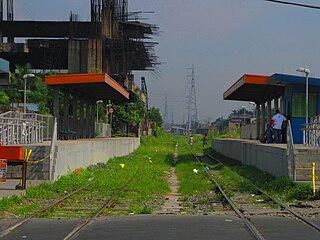
The Philippine National Railways (PNR) is a state-owned railway company in the Philippines which operates one commuter rail service between Metro Manila and Laguna, and local services between Sipocot, Naga and Legazpi in the Bicol Region. It is an attached agency of the Department of Transportation.

Rail transportation in the Philippines is currently used mostly to transport passengers within Metro Manila and provinces of Laguna and Quezon, as well as a commuter service in the Bicol Region. Freight transport services once operated in the country, but these services were halted. However, there are plans to restore old freight services and build new lines. From a peak of 1,100 kilometers (680 mi), the country currently has a railway footprint of 533.14 kilometers (331.28 mi), of which only 129.85 kilometers (80.69 mi) are operational as of 2023, including all the urban rail lines. World War II, natural calamities, underspending, and neglect have all contributed to the decline of the Philippine railway network. In the 2019 Global Competitiveness Report, the Philippines has the lowest efficiency score among other Asian countries in terms of efficiency of train services, receiving a score of 2.4, and ranking 86th out of 101 countries globally. The government is currently expanding the railway network up to 1,900 kilometers (1,200 mi) by 2022 through numerous projects.
A limited express is a type of express train, and express bus service. It refers to an express service that stops at a limited number of stops in comparison to other express services on the same or similar routes.

Paco station is a railway station located on the South Main Line in the city of Manila, Philippines. It was originally opened by the Manila Railroad Company in 1908 as a major hub in the southern half of Manila, where trains toward Cavite province once operated. The old train station building was designed by William E. Parsons and was completed in 1915. Prior to the electrification plan in the late 1970s, Paco was the southernmost double-track station on the line.

Sucat station is a railway station located on the South Main Line in Muntinlupa, Metro Manila, Philippines. It was originally established by the Manila Railway Company in 1908 as part of the construction of the original Southern Lines to the province of Tayabas, since renamed Quezon. It is also the southernmost area on the PNR Metro Commuter Line to be upgraded to double track as a result of a proposed electrification scheme in 1978.
Muntinlupa station is a railway station located on the South Main Line in Muntinlupa, Metro Manila, Philippines. The old station was removed together with the I.S. during the clearing operations in 2009. The new station was supposed to be constructed years earlier which was within the proposed Phase 2 of the Northrail-Southrail Linkage Project that should have rehabilitated and double tracked the South Main Line from Sucat to Calamba. The new station's construction started and got finished only on 2013 without the track duplication of the line. The new station was formally opened on December 23, 2013. This station is planned to be the new terminus of the Metro Commuter although there is no confirmation and no specific date yet given by PNR.

Mamatid station is a railway station located on the South Main Line in Laguna, Philippines.

Balagtas station is a former railway station located on the North Main Line in Bulacan, Philippines. It is currently being rebuilt as part of the first phase of the North–South Commuter Railway. It was also the terminus of the defunct Balagtas–Cabanatuan line.

The PNR Metro Commuter Line is a commuter rail line operated by the Philippine National Railways. It was first inaugurated as the Metro Manila Commuter Service in 1970, and originally served the North Main Line and the South Main Lines, as well as the defunct Carmona and Guadalupe branch lines. Since then, it adopted several names such as Metrotrak and Metrotren, before adopting its present name in the late 2000s. The line is also nicknamed the Orange Line due to its designation in the 1970s.
The Light Rail Transit Line 6 is a proposed rapid transit system in Cavite, Philippines. There have been two proposals for the line, with the first one shelved immediately in 2018. Another proposal emerged in 2017 and is currently under review by the National Economic and Development Authority (NEDA).
The Metro Manila Subway, formerly known as the Mega Manila Subway (MMS), is an under-construction underground rapid transit line in Metro Manila, Philippines. The 36-kilometer (22 mi) line, which will run north–south between Quezon City, Pasig, Makati, Taguig, Parañaque and Pasay, consists of 15 stations between the East Valenzuela and Bicutan stations. It will become the country's second direct airport rail link after the North–South Commuter Railway, with a branch line to Ninoy Aquino International Airport.

The North–South Commuter Railway (NSCR), also known as the Clark–Calamba Railway, is a 147-kilometer (91-mile) urban rail transit system under construction in the island of Luzon, Philippines. Running from New Clark City in Capas to Calamba, Laguna with 36 stations and four services, the railway was designed to improve connectivity within the Greater Manila Area and will be integrated with the railway network in the region.
IRRI station is a railway station located on the South Main Line in Los Baños, Laguna, Philippines. It is a flag stop for the line as there are no platforms yet being erected, temporary stairs for the trains are added in the meantime to facilitate loading and unloading.

The PNR South Main Line is one of the two trunk lines that form the Philippine National Railways' network in the island of Luzon, Philippines. It was opened in stages between 1916 and 1938 by the Manila Railroad. Services peaked in the 1940s until the late 1960s, when the system started to decline. Since 1988, it was the only functioning inter-city rail after its counterpart to the north, the North Main Line, was closed. The intercity section of the line in Laguna, Quezon and the Bicol Region was then closed and reopened repeatedly between 2004 and 2014 due to a combination of declining ridership and was closed since then. Currently, only two short sections of the line survive; the PNR Metro Commuter Line between Tutuban station and Laguna, and the Bicol Commuter regional rail service between Sipocot and Naga, Camarines Sur.
Los Baños station is a railway station located on the South Main Line in Los Baños, Laguna, Philippines.

The PNR South Long Haul Project, also known as PNR Bicol is a proposed inter-city rail line in southern Luzon, Philippines. It is part of the larger Luzon Rail System, a network of long-distance standard-gauge lines being built by the Philippine National Railways throughout Luzon. It is one of the two lines that will reconstruct the historic PNR South Main Line, along with the electrified North–South Commuter Railway South section to Calamba, Laguna.

The PNR North Main Line is one of the two trunk lines of the Philippine National Railways in the island of Luzon, the other being the PNR South Main Line. The line during its maximum extent led to various cities and municipalities in Central Luzon and the Ilocos Region.

The PNR EM10000 class is an electric multiple unit commuter trainset that will be operated by the Philippine National Railways on the North–South Commuter Railway. Prior to the reveal of its numbering scheme in October 2021, the train was known as the PNR Sustina Commuter. Set to enter service by 2023, it will be PNR's first trainset to be run on standard gauge and powered by electric traction. The trains are also designed to be interoperable with the Metro Manila Subway.

















